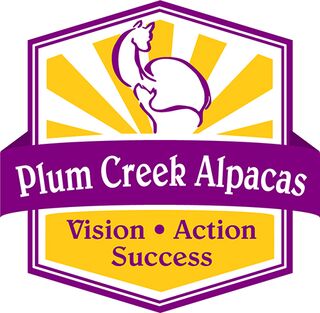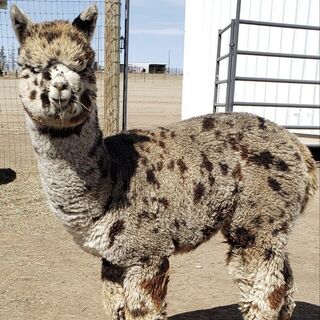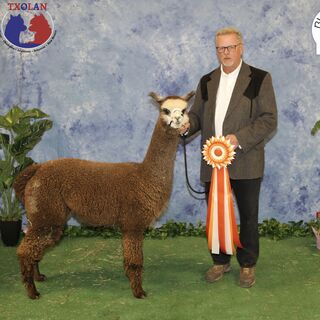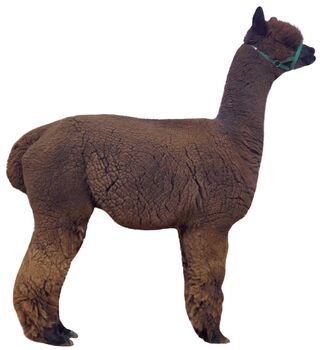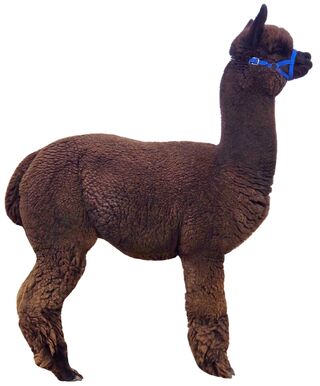HALTERS, LEADS AND TRAINING
HALTERS, LEADS AND TRAINING
Halters
Appropriate Alpaca halters, leads, and training will bring lifelong benefits. Halters should only be put on an Alpaca when you want to train them, move them, or restrain them—which means that you are always with them when they have them on. They should never be left on the Alpaca long term. The only time we leave a halter on is when they are put into the trailer. Leaving them on for any other length of time is dangerous. They can get caught on something and cause the Alpaca to panic. Also, leaving them on all the time causes the fiber to grow around it, and the stain on the halter to transfer to the Alpaca. It’s not a pretty sight. We’ve seen an Alpaca with blue lines on its face and head.
Halters should be fitted on alpacas so that the nosepiece allows for chewing. But take care that it cannot slide down onto the soft cartilage of the nose and cut off breathing. The band behind the ears should be high and snug, holding the noseband in place. Improperly fitted halters can be life-threatening because, unlike some animals, camelids are obligatory nasal breathers; this means they cannot breathe through their mouth if the nose is obstructed. There are various brands of halters, with several being made in cottage industries by knowledgeable and talented people.
While Zephyr is one brand that we have found to be worth the money, we have also utilized other brands with success. You should be looking for an appropriate number of adjustable points. Also, having the bottom ring made into a non-movable position on the second chin strap helps make an Alpaca under better control when on the lead.
Leads
A good lead is one that is round, soft, and not too large in diameter. Buying them from a specialty firm is well worth the money that you will spend on them. Dog leads are usually flat and can cut into your hand if they jerk away. Horse leads are both too long and too large in diameter. We prefer 1/4″ and 3/8″ leads about 5’ long.
Learn how to tie a safety tie with your lead. It is a quick release method that holds your Alpaca securely to a rail or post. There are plenty of videos on this available online. Here are two:
Preparation for Training
When training a cria for the first time you should delay until they are at least 4 months old. Their nose is growing during their early life. Much of it is made of softer cartilage. Training too early can damage it.
Training Procedure
For us, we play follow the leader. We get a young yearling to lead the group with the junior alpacas following, as they get more comfortable we will move a junior to the front, when that junior gets uncomfortable we will move it back in the line. (this form of training takes extra handlers). It also keeps the slower, younger ones from always turning around to see who is threatening their space. The side benefit, of course, is that they all see a halter daily. We have combined that feeding time with halter training time.
Another option is walking them between two well-trained older animals, this sometimes encourages them to accept their restraint of freedom.
Many people recommend a slight tug, then release, then a slight tug, then release. If the cria makes ANY movement forward, immediately release your pressure on the lead. (Pulling on the lead puts pressure on the halter strap behind the ears, which is annoying.) If the cria moves forward to relieve the pressure, you reward her by letting the lead go loose so it gets the point—moving forward is the reward.
You can also reward with food, but don’t use this continuously as they might get pushy about it during training. But just like training dogs, food rewards do work. Start by rewarding even a baby step forward and, when they are consistently taking one step forward, start requiring two, then three, etc. The alpaca will be walking with you in no time. And, of course, patience is the key!
HERD HEALTH https://www.plumcreekalpacas.com/page/10282/herd-health
Thank you for permissions to use this information. https://www.facebook.com/aubrey.oaks.alpacas
Friday, January 12, 2024
